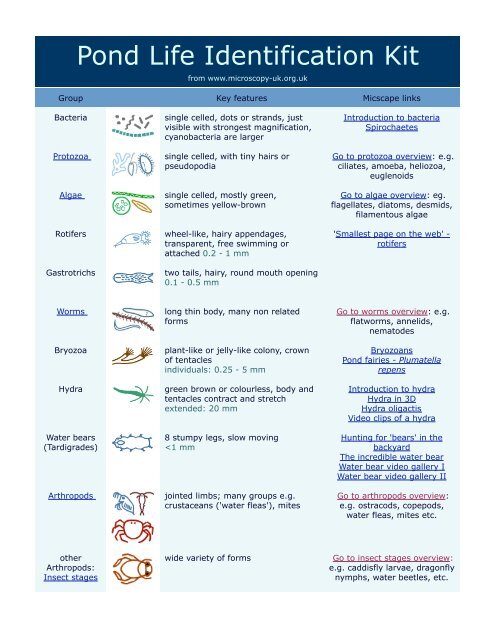Pond life identification - ingridscience.ca
Pond life identification - ingridscience.ca
Pond life identification - ingridscience.ca
You also want an ePaper? Increase the reach of your titles
YUMPU automatically turns print PDFs into web optimized ePapers that Google loves.
<strong>Pond</strong> Life Identifi<strong>ca</strong>tion Kit<br />
from www.microscopy-uk.org.uk<br />
Group Key features Mics<strong>ca</strong>pe links<br />
Bacteria single celled, dots or strands, just<br />
visible with strongest magnifi<strong>ca</strong>tion,<br />
cyanobacteria are larger<br />
Protozoa single celled, with tiny hairs or<br />
pseudopodia<br />
Algae single celled, mostly green,<br />
sometimes yellow-brown<br />
Rotifers wheel-like, hairy appendages,<br />
transparent, free swimming or<br />
attached 0.2 - 1 mm<br />
Gastrotrichs two tails, hairy, round mouth opening<br />
0.1 - 0.5 mm<br />
Worms long thin body, many non related<br />
forms<br />
Bryozoa plant-like or jelly-like colony, crown<br />
of tentacles<br />
individuals: 0.25 - 5 mm<br />
Hydra green brown or colourless, body and<br />
tentacles contract and stretch<br />
extended: 20 mm<br />
Water bears<br />
(Tardigrades)<br />
Arthropods<br />
other<br />
Arthropods:<br />
Insect stages<br />
8 stumpy legs, slow moving<br />
Worms<br />
Group Key features Mics<strong>ca</strong>pe links<br />
Flatworms<br />
(Platyhelminthes)<br />
Segmented worms<br />
(Annelids)<br />
Roundworms<br />
(Nematodes)<br />
not to be mistaken<br />
for worms:<br />
flattened, 2 or more eye spots, move<br />
in gliding fashion<br />
1 - 15+ mm<br />
oligochaetes: 1.5 mm. to >2cm long,<br />
hair bundles, (includes earthworm<br />
and Tubifex)<br />
leeches: characteristic 'leech-like'<br />
motion, suckers each end >1 cm<br />
move very franti<strong>ca</strong>lly, often in 'S'<br />
curves,<br />
0.2 - 10 mm<br />
Hydra, has tentacles<br />
extended: 2 cm<br />
larger ciliated protozoa like<br />
Spirostomum (has very fast<br />
contraction)<br />
insect stages like mosquito larva,<br />
these have a more distinct head than<br />
the worms above, also antennae/<br />
legs<br />
image of flatworm<br />
image of oligochaete<br />
image of nematode<br />
Introduction to hydra<br />
Spirostomum<br />
Go to arthropods overview
Arthropods<br />
Arthropods are characterised by jointed limbs and include major groups like the crustacea, insects,<br />
spiders and mites. They have many segments, a tough outer skeleton and many modified limbs.<br />
There are many microscopic and macroscopic types that occur in freshwater.<br />
There are several other groups with limb-like structures that aren't arthropods. Check rotifers and<br />
hydra on the first page.<br />
Group key features Mics<strong>ca</strong>pe links<br />
Crustacea -<br />
Ostracods<br />
Crustacea -<br />
Copepods<br />
Crustacea -<br />
Water fleas<br />
'Cladocera'<br />
Water bears<br />
(Tardigrades)<br />
bean-like shell
Insect stages<br />
Some species are entirely aquatic, whereas other insects only live in the water during their larval<br />
stages or as nymphs. When insects undergo a metamorphosis we <strong>ca</strong>ll the immature form larva.<br />
When they gradually transform via moults into the adult form the young stages are <strong>ca</strong>lled nymphs.<br />
Note on size: Many aquatic insects and their immature stages <strong>ca</strong>n vary in size from a few mm to<br />
3cm or more depending on e.g. maturity and species, so sizes have been omitted for most groups.<br />
Group key features<br />
Alderfly nymph one tail, long filaments along the abdomen<br />
Caddisfly larva most species build a cylindri<strong>ca</strong>l <strong>ca</strong>se for protection, each species<br />
makes a distinct <strong>ca</strong>se from different material<br />
Stonefly nymph two jointed tails<br />
Mayfly nymph three jointed tails, leaf-like (or other shaped) 'gills' on its sides<br />
Damselfly<br />
nymph<br />
three leaf-like tail appendages (gills), bizarre extendable jaws<br />
Dragonfly nymph robust, no tail appendages, bizarre extendable jaws<br />
Water bug<br />
nymph/adult<br />
Water-beetle<br />
larva<br />
Water beetle<br />
adult<br />
no jaws, like all water bugs they possess a tube-like beak, the<br />
nymphs don't have wings,<br />
Some common forms: Backswimmer, water boatman. On the water<br />
surface: <strong>Pond</strong> skater<br />
strong jaws, long segmented body, short legs<br />
strong jaws, tough shield, many water beetles are fierce predators<br />
Springtail the grey spring-tail (the most primitive insect group) Podura aquati<strong>ca</strong><br />
lives on the surface of the water, often in large numbers, 0.5-2.5mm<br />
Visit the Postal Microscopi<strong>ca</strong>l Society (UK) Springtail Group site for<br />
overview and projects<br />
Mosquito larva with a long slender body, often moves in S-shaped curves,<br />
Dronefly larva this so <strong>ca</strong>lled rat-tailed maggot has a long tubed tail for breathing<br />
Other<br />
Arthropods that<br />
are not insects<br />
Go to arthropods overview: e.g. ostracods, copepods, water fleas,<br />
mites etc.


